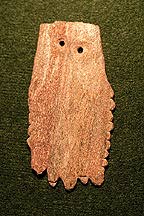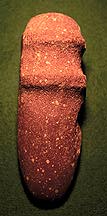Inference In Archaeology
Lets look at several more things. First , lets look at the artifact to
the left of this text. What do know through observation and what can we
infer? We know that it is made of a piece of rock known as schist. It has
a seriated edging and two holes have been drilled into it. We also know
that it is rather thin and relatively light weight.
, lets look at the artifact to
the left of this text. What do know through observation and what can we
infer? We know that it is made of a piece of rock known as schist. It has
a seriated edging and two holes have been drilled into it. We also know
that it is rather thin and relatively light weight.
So what can we infer from this? Can we infer a use for
example? Was this artifact the depiction of an owl? Was it worn as a pendant?
Can we make these inferences. It looks like an owl in a way. The holes could
have been used to tie it in some way so that it could have been worn around
someone's neck. The question is whether these are safe inferences?
 The artifact to the right
is what archaeologists call a "three-quarter grooved axe". There
is a groove carved at the top of the axe that surround three-quarters of
it so there is the basis for the name. What we know is that this was found
at a site in Tempe Arizona. The raw material is not locally available and
we know that it can be found in the Verde Valley nearly 80 miles to the
north. It is a very distinctive type of rock that this particular axe was
made form. Therefore, we can trace where the source for this raw material
comes from. We can infer that people probably traded for this axe. We don't
know if they traded for the raw materials or the finished axe itself. It
is more likely that trade was involved because we know from other lines
of evidence that trade was an important aspect to the people living in the
Phoenix/Tempe area at the time.
The artifact to the right
is what archaeologists call a "three-quarter grooved axe". There
is a groove carved at the top of the axe that surround three-quarters of
it so there is the basis for the name. What we know is that this was found
at a site in Tempe Arizona. The raw material is not locally available and
we know that it can be found in the Verde Valley nearly 80 miles to the
north. It is a very distinctive type of rock that this particular axe was
made form. Therefore, we can trace where the source for this raw material
comes from. We can infer that people probably traded for this axe. We don't
know if they traded for the raw materials or the finished axe itself. It
is more likely that trade was involved because we know from other lines
of evidence that trade was an important aspect to the people living in the
Phoenix/Tempe area at the time.
 Lets look at
one more example. The picture at the right is of two clay figurines. We
can observe that these are similar in design to others than have been found
in northern Mexico. Knowing this, archaeologists have inferred that there
was a Mexican influence on the early development of cultures in southern
Arizona. Other archaeologists are not sure that this influence was that
great and would argue that development of cultures in southern Arizona was
more an indigenous development than one influenced by outside forces.
Lets look at
one more example. The picture at the right is of two clay figurines. We
can observe that these are similar in design to others than have been found
in northern Mexico. Knowing this, archaeologists have inferred that there
was a Mexican influence on the early development of cultures in southern
Arizona. Other archaeologists are not sure that this influence was that
great and would argue that development of cultures in southern Arizona was
more an indigenous development than one influenced by outside forces.
What should be apparent is that inference is something
archaeologist use very carefully. They want to make as many observations
as possible before making an inference.
 , lets look at the artifact to
the left of this text. What do know through observation and what can we
infer? We know that it is made of a piece of rock known as schist. It has
a seriated edging and two holes have been drilled into it. We also know
that it is rather thin and relatively light weight.
, lets look at the artifact to
the left of this text. What do know through observation and what can we
infer? We know that it is made of a piece of rock known as schist. It has
a seriated edging and two holes have been drilled into it. We also know
that it is rather thin and relatively light weight.

